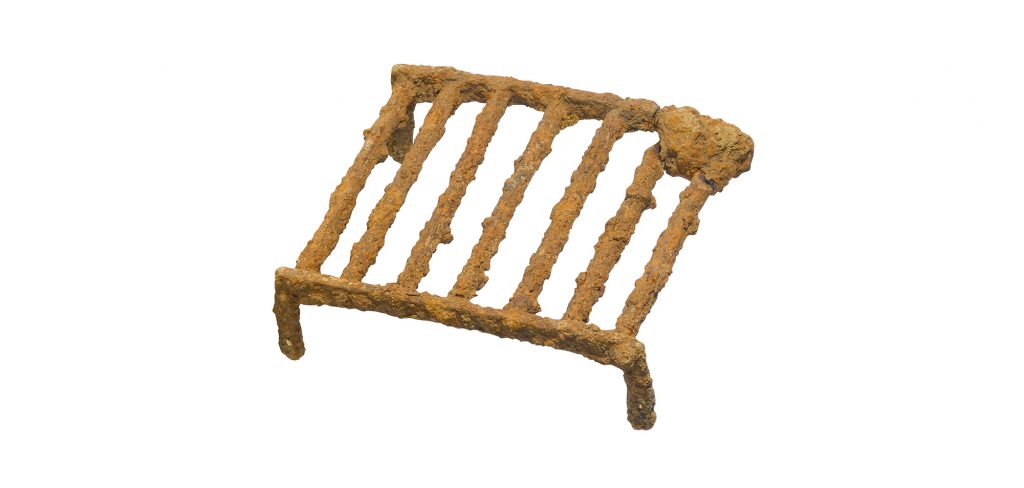MOLA Headland Registered Finds Specialist, Owen Humphreys, explores what a Roman gridiron can tell us about cooking technology in Roman Cambridgeshire.
One of the largest ‘smallfinds’ from the A14 excavations is a complete Roman gridiron, found deposited in a ditch. Known as a craticula in Latin, gridirons like this were a new development in cooking technology during the Roman period.
A gridiron is a metal framework that could be placed over a fire to provide a surface to cook on. This iron example formed a grill. Objects of this type are unknown in pre-Roman Britain, but can be found across the Empire. Other examples have been found in Colchester and Silchester, in France, Germany, Austria and Switzerland, whilst a mosaic in the Rio Verde villa in Marbella, Spain, depicts a gridiron alongside meat, vegetables and other cooking equipment, including knives, spatulas and tripod stands.
This mosaic and the form of the objects give us clues about the everyday cooking practices of the Roman period. With their short legs, these gridirons are likely to have been used on raised table-level hearths, forming a sort of early cooking range. Gridirons could have been used to stand flat-bottomed cauldrons and pots over the fire, alongside tripod stands for their round-bottomed equivalents.
Gridirons could also be used to barbeque meat and vegetables directly over the hearth. Perhaps this is what the fish and rabbit on the Marbella mosaic were being prepared for. On our example, the square-sectioned grill bars are turned to have their corners facing upwards, making a very effective grill. The size of these gridirons suggests they were used for cooking at an individual household level.
The simple Cambridgeshire gridiron marks a sharp contrast with the ornate cooking implements we find from the Iron Age which preceded the Roman period. At nearby Welwyn, in Hertfordshire, elaborate iron ‘fire-dogs’ were found in Iron Age princely burials (now on display in the British Museum). These large objects, decorated with forged animal heads, would have been used to spit-roast meat over floor-level hearths. Their size, value, and association with other feasting equipment in the burials, indicates their use in communal events designed to show off the status of the host. Whilst these fire-dogs are a far cry from the simple cooking grills of the Roman period, they probably would only have been owned by a few, wealthy members of society. By the Roman period, we start to find more evidence of iron cooking equipment in humbler social situations, suggesting an increase in material wealth and consumption at all levels of society.
The deposition of expensive feasting equipment in Iron Age graves is something we can readily understand as a sign of beliefs in the afterlife, and the need for funerary status displays. One of the questions still to be answered about the A14 gridiron is why such a large iron object was deposited in a ditch rather than recycled. As work continues to understand the site, we will be able to gain a more complete understanding of its place, and the reasons for its eventual deposition and survival in such a complete state.
Join us on our journey!
- Twitter: @A14C2H #A14Archaeology
- Facebookcom/A14C2H/#A14Archaeology
- Find out more about the A14C2H improvement scheme here
The archaeological programme for the A14 Cambridge to Huntingdon improvement scheme is being carried out by the A14 Integrated Delivery Team on behalf of Highways England.

0 Comments
Leave A Comment